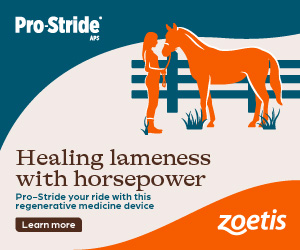Is My Horse Fit Enough?

While a dressage horse might be a different sort of “fit” than an event horse, there are still parts of any program that should be dedicated to developing strength and fitness in the horse. Not only will your horse be more mentally inclined to work hard for the rider, but his muscles will also be better developed for the task.
So how can you tell if your horse is fit?
To answer this question, we recruited the help of Dr. Ashley Taylor-Zion, an equine veterinarian with Sports Medicine Associates of Chester County in Pennsylvania. Dr. Taylor-Zion has worked with horses of every discipline, ranging from Olympic event horses to pleasure horses.
“One of the biggest determining factors for horse fitness is body condition and muscling,” Dr. Taylor-Zion explained. “We see a lot of different horses at various stages of their career, and we look at body condition and performance history to determine where they should be with fitness and what can be improved.”
Doing too much too fast, before the muscles are properly developed, can be damaging for both the horse’s body as well as its brain.
It’s a bit easier to determine fitness for an event horse or a racehorse, she says. Cardiovascular training is already a key part of these horses’ fitness programs, so a heart monitor can tell a lot about their level of fitness. However, for horses that are not reaching those higher levels of heart rate, there are other factors to consider.
Body condition scores for a high performance hunter versus a lower level dressage horse will clearly be different. The breed of the horse also plays into its results.
Some horses will carry a higher fat-to-muscle ratio than others, so taking into account the performance history of the horse is important, Dr. Taylor-Zion explains.
“For show horses, I will try to find out as much about their history as I can,” she said. “If they’re a jumper, for example, I’ll want to know if they show consistently throughout the year or if they have down time regularly. I’ll use muscle conditioning to see where the horse is in its training. Does it have good muscle definition for the sport it competes in? Is the hind end underdeveloped?”
Another important way to judge fitness is how quickly a horse recovers.
Considering heart rate and respiratory rate, a horse that is able to recover within 10 minutes can generally be considered fit for its job. This, of course, can be affected by the level of the horse’s anxiety or excitement, the temperature at the time, and other factors. A useful guideline, Dr. Taylor-Zion says, is to see how quickly the horse’s breathing and heart rate return to normal, generally speaking.
To gauge just how fit a horse is while riding, FEI dressage rider, Mary Bahniuk Lauritsen, suggests paying attention to a horse’s breathing during breaks in between performance.
“Personally in my training I think it’s really important to build fitness by making sure your horse is having adequate breaks in between,” said Mary, who is from Harvard, Mass. “I think you really notice during those breaks how your horse is breathing, how much they are sweating, and what kind of energy level you feel beneath you.”
Energy levels can be deceiving. There are horses who just have that nature where they can go, go, go.
Mary suggests building correct muscle and topline with horses. She added that she enjoys the transformative process many horses undergo after a few months in her program. Building muscle and fitness is a part of the job that she enjoys, but she cautions riders against going too hard too soon.
“Energy levels can be deceiving,” she explained. “There are horses who just have that nature where they can go, go, go. The ‘go’ horses you have to be the most careful with because you can get overzealous with a horse that is just so eager to please or is a thoroughbred type. If you keep going until they’re dripping in sweat, you’re not building them up, you’re actually breaking them down. You want to build fitness slowly.”
Dr. Taylor-Zion agrees with this concept, emphasizing the importance of slowly building fitness.
“Just because a horse is not doing aerobic work like an event horse would be doing does not mean they are not building fitness, but you have to do it over time,” she said. “Doing too much too fast, before the muscles are properly developed, can be damaging for both the horse’s body as well as its brain. I will often recommend walking and, eventually, trotting hills for most horses, no matter what sport, but I tell people to start slow and build rather than throwing everything their way at one time.”



